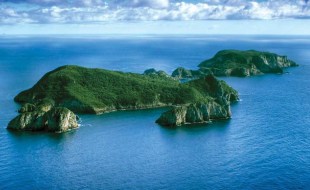We have hunted out our five favourite dive sites in New Zealand. New Zealand reportedly has more scuba divers per capita than any other country in the world. Whether it's cruising around reefs in subtropical Northland water, or exploring a subterranean fresh-water cave system, Kiwis are at home under the water.
POOR KNIGHTS ISLANDS
If you're looking for superb diving opportunities in New Zealand, you cannot go past the Poor Knights Islands, off the coast of Tutukaka, near Whangarei. Jacques Cousteau named it as one of the top 10 dive sites in the world and more recently Diver magazine called it the world's best subtropical dive.
Warm currents swept in from tropical waters further north support 125 different species of fish, as well as corals, sponges, kelp forests and stingrays. This is the place to go for stunning displays of underwater colour: Reef fish mingle with sponges, anemones and vibrant seaweeds.
The islands are the remains of a group of 11-million-year-old volcanoes and underwater cliffs drop to 100m below sea level in places. Caves and archways shelter species that usually would be found much deeper than they are here - in the Rikoriko Cave, 10m below the surface, is a sponge usually found 200m down.
The Poor Knights include the world's largest sea cave - so big that it's reputed to have hidden a Japanese submarine during World War II.
Visibility is best in winter, when divers can see up to 30m. But as the water warms up, plankton moves in and decreases visibility, although it boosts fish life. Watch out for passing humpbacks and turtles.

RAINBOW WARRIOR
Still in the north, Greenpeace's flagship boat was sunk at the Cavalli Islands in 1987, two years after its infamous bombing in the Auckland harbour. It is now an artificial reef teeming with marine life and a very popular dive site. But reports from divers say that the wreck appears to be disintegrating at an increasing rate, so this is one to visit sooner rather than later. The wreck is 27m below the surface, and about 40m in length.
It is covered with gorgeous jewel anemones - but some experts say it takes a night dive to see them at their very best. On a normal day you could expect to come face-to-face with golden snapper, kingfish, john dory, mackerel, scorpion fish, moray eels and crayfish.
There are usually mild currents and visibility is good from February until the end of June.
RIWAKA CAVERNS
A unique opportunity for divers of any skill level, the Riwaka Caverns near Nelson are a massive underground network of caves and tunnels, filled with fresh water. A bush walk leads you to the start of the dive, where you slip underwater and swim through a series of enormous caverns.
It's cold and very dark at the beginning but once you surface inside, you can take your scuba equipment off and marvel at the stalactite and stalagmite formations as well as a waterfall of pink limestone inside the cave at the end of the second sump.
Divers comment on the unexpected size of everything to do with this dive - from the boulders they clamber over to the caves themselves. Explorers have so far ventured about 800 metres into the network, called the Riwaka Resurgence.
WHITE ISLAND
There are not many places in the world where you can dive around a live volcano but New Zealand is one of them.
White Island, about 50km off the coast of Whakatane, is a 200,000-year-old volcano surrounded by water that is full of marine life, including kingfish, stingrays, moray eels and blue maomao.
Fissures in the rocks create a ''spa-pool'' effect of bubbles in places. The water temperature hovers about 18 degrees but can get to 22 degrees in summer and divers report up to 50m visibility, with reefs, pinnacles, drop-offs, boulders, archways and plateaus to explore. Stop for lunch or to snorkel at Champagne Bay, which gets its name from the thermal activity in the water. Rare diadema urchins have made their home at White Island - check them out at Diadema Rock.
HMNZS WELLINGTON (F69)
After 18 years in the New Zealand navy, the Wellington is now the most accessible dive wreck on the planet, just off the coast of Wellington, about 10 minutes from the airport. Scuttled in 2005, the wreck has been broken up into three sections by currents and is a living reef, home to many different species of fish.
The wreck is roughly 24m down, with visibility of about eight metres. Being Wellington, divers are warned to watch for currents. Dive around the gun turret or take in the exterior of the ship - diving in the midship and stern sections is not advised. This is as safe as it gets for wreck diving, though, you will not even need a torch.
Article courtesy of Hamilton News - 3/12/12